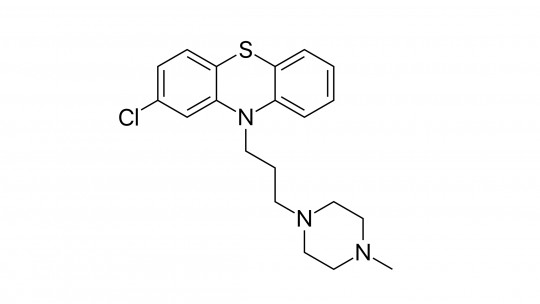
There are different types of antipsychotics. These can be classified according to their time of appearance (first or second generation; typical and atypical) and according to the class of medications to which they belong.
In this article we will talk about a specific antipsychotic: mesoridazine, belonging to the phenothiazines (a group of antipsychotics) We will know its characteristics, what it is used for and its therapeutic and adverse effects.
Antipsychotic drugs
Before delving into mesoridazine, which is an antipsychotic, we are going to briefly explain what exactly these drugs are. Antipsychotics are drugs, as their name suggests, that relieve psychotic symptoms, such as hallucinations or delusions However, they are also often used to treat other symptoms, such as agitation or excessive restlessness.
That is why they are frequently prescribed to people who suffer from a psychotic disorder (such as schizophrenia), but also to people who suffer from confusion, delirium, agitation, movement disorders and tics (for example Gilles de la Tourette), etc. .
Its mechanism of action involves blocking dopamine receptors which causes the levels of this neurotransmitter to decrease (it has been observed how people with schizophrenia have abnormally high levels of dopamine).
Specifically, antipsychotics They block a receptor called D2, which affects four brain pathways: the mesolimbic, the nigrostriatal, the mesocortical and the tuberoinfundibular Blocking these four pathways produces different adverse effects, but also the desired therapeutic effects (the latter, through blocking the mesolimbic and mesocortical pathways).
Now, we are going to talk about mesoridazine, a type of antipsychotic drug belonging to the phenothiazines (a chemical compound).
Mesoridazine
Mesoridazine (trade name: Serentil) is an antipsychotic (neuroleptic) drug, used to treat schizophrenia, to relieve symptoms such as hallucinations, delusions, and agitation.
Specifically, mesoridazine is a piperidine neuroleptic (a type of organic compound), and belongs to a class of medications: phenothiazines. In turn, it is a metabolite of thioridazine (another antipsychotic drug typical of piperidine).
On the other hand, it should be said that, today, mesoridazine is not marketed worldwide. This It was withdrawn from the market in the United States in 2004 due to its side effects, which turned out to be dangerous.
These effects included: irregular heartbeat and prolongation of the QT interval of the electrocardiogram. Note that prolongation of the QT interval can generate ventricular arrhythmias in the patient.
Indications
The main indication for mesoridazine is schizophrenia It is used, as we have seen, to treat its associated symptoms, which are: hallucinations, delusions and agitation.
Thus, mesoridazine It is effective in treating psychotic symptoms, but also others such as agitation, restlessness or tension most typical symptoms of anxiety disorders.
Effects at the brain level
Mesoridazine has different effects on the brain: antidopaminergic effects (which results in a decrease in dopamine), central antiadrenergic (decrease in adrenaline), antiserotonergic (decrease in serotonin) and muscarinic anticholinergic (the latter are weak).
Phenothiazines
We have seen that mesoridazine belongs to the phenothiazine class of medications. Mesoridazine is included in this group along with other drugs, such as: piperacetazine, pipopthiazine, propericiazine, sulforidazine and thioridazine.
But what exactly are phenothiazines? It is a chemical compound, yellowish/greenish in color. Its structure is made up of three rings; specifically, Its tricyclic nucleus is formed by two benzene rings, a sulfur atom and a nitrogen atom
Thus, phenothiazines are actually considered a group of antipsychotics. In turn, these are divided into three subgroups (differentiated by their chemical structure and pharmacological properties): piperidines, piperazines and aliphatic compounds. Mesoridazine specifically belongs to the first group, that of piperidines (as we have already seen).
Dosage and format
Mesoridazine is marketed in different formats: injection, liquid concentrate, and tablets. Mesoridazine is generally taken in tablet form but this will vary depending on the patient (their profile and needs).
Normally, it is recommended to take it concentrated in water or with orange juice. If taking mesoridazine in injection format, it is recommended to rest for at least half an hour after administration.
Doses must be prescribed by the doctor, which generally prescribes regular, daily doses. It is important not to stop taking mesoridazine (as well as most drugs) suddenly, and much less without consulting a specialist; Doing so could worsen pre-existing symptoms.
Side effects
Like most drugs, mesoridazine also has side effects. The most common are: weight gain, restlessness, anxiety, constipation, headache, diarrhea, nausea, dizziness, vomiting and changes in appetite.
More serious effects
The effects mentioned are the most frequent, although if other more serious ones appear, It is important to go to the specialist as soon as possible ; We talk about symptoms like (they are just some of them):
Other serious effects
On the other hand, we should especially mention three serious side effects that mesoridazine can cause: akathisia, tardive dyskinesia and neuroleptic malignant syndrome (NMS). These consist of:
1. Akathisia
Akathisia, one of the possible side effects of mesoridazine consists of the inability to stay still along with a feeling of restlessness
2. Tardive dyskinesia
Tardive dyskinesia is a very typical side effect of antipsychotics. It consists of a movement disorder, which encompasses a series of symptoms that mainly include involuntary movements.
3. Neuroleptic Malignant Syndrome (NMS)
Finally, Neuroleptic Malignant Syndrome includes symptoms such as stiffness, fever, dyspnea, and arrhythmias This is a very serious but rare syndrome, which can cause death, and lasts between 5 and 15 days if you do not die.
NMS can be caused by multiple antipsychotics, not just mesoridazine.








